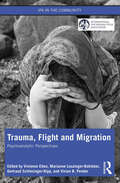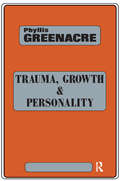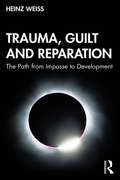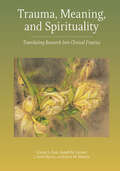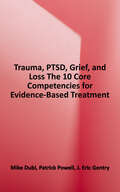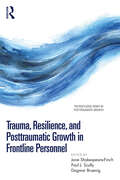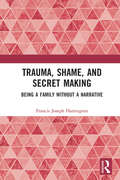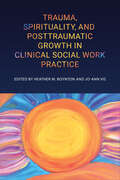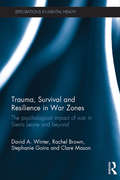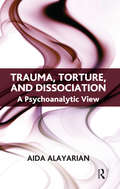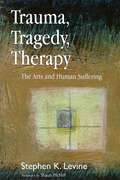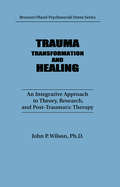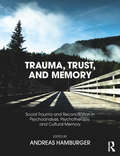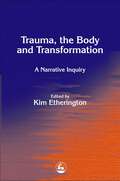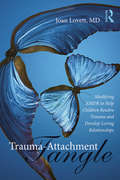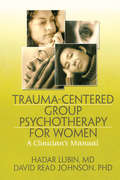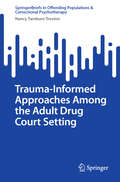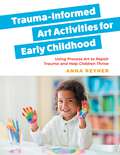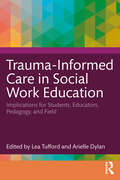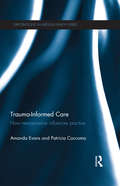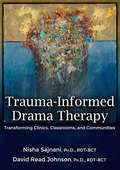- Table View
- List View
Trauma, Flight and Migration: Psychoanalytic Perspectives (IPA in the Community)
by Marianne Leuzinger-Bohleber Vivian B. Pender Vivienne Elton Gertraud Schlesinger-KippThis book brings together leading international psychoanalysts to discuss what psychoanalysis can offer to people who have experienced trauma, flight, and migration. The four parts of the book cover several elements of this work, including psychoanalytic projects beyond the couch, and collaboration with the UN. Each chapter presents an example of the applications of psychoanalysis with a specific group or in a particular context, from working with refugees in China to understanding the experiences of women who have witnessed political violence in Peru. Psychoanalytic work with Trauma, Flight and Migration provides a compelling exploration of the international contributions made by psychoanalysis. This innovative book will be essential reading for psychoanalysts and psychoanalytic psychotherapists looking to learn more about working with people who have experienced the impact of traumatic movement or migration.
Trauma, Growth and Personality (Maresfield Library)
by Phyllis GreenacreThis collection of papers focuses on the interaction of maturation phases and special traumas in the first few years of life and the probable effect of these early patterns on the structure of the later personality.
Trauma, Guilt and Reparation: The Path from Impasse to Development
by Heinz WeissTrauma, Guilt and Reparation identifies the emotional barriers faced by people who have experienced severe trauma, as well as the emergence of reparative processes which pave the way from impasse to development. The book explores the issue of trauma with particular reference to issues of reparation and guilt. Referencing the original work of Klein and others, it examines how feelings of persistent guilt work to foil attempts at reparation, locking trauma deep within the psyche. It provides a theoretical understanding of the interplay between feelings of neediness with those of fear, wrath, shame and guilt, and offers a route for patients to experience the mourning and forgiveness necessary to come to terms with their own trauma. The book includes a Foreword by John Steiner. Illustrated by clinical examples throughout, it is written by an author whose empathy and experience make him an expert in the field. The book will be of great interest to psychotherapists, social workers and any professional working with traumatized individuals.
Trauma, Meaning, and Spirituality: Translating Research into Clinical Practice
by Crystal L. Park Joseph M. Currier J. Irene Harris Jeanne M. SlatteryTrauma represents a spiritual or religious violation for many people. Survivors attempt to make sense out of painful events, incorporating that meaning into their current worldview in either a harmful or a more helpful way. This volume helps mental health practitioners—many of whom are less religious than their clients—understand the important relationship between trauma and spirituality, and how to best help survivors create meaning out of their experiences. Drawing on relevant theories and research, the authors present a new conceptual framework, the Reciprocal Meaning-Making Model, demonstrating how it can guide both assessment and treatment. Through the use of case material, the authors examine a range of spiritual views, traumas, and posttraumatic reactions that are reflective of the population as a whole rather than targeting only specific religions or cultural perspectives. Given the lack of scientific literature on the topic, this book fills an important gap, and will appeal to clinicians and researchers alike.
Trauma, PTSD, Grief & Loss: The 10 Core Competencies for Evidence-Based Treatment
by J. Eric Gentry Mike Dubi Patrick PowellTrauma, PTSD, Grief & Loss provides a holistic and systemic path to understanding traumatic stress, and charts the most effective treatments, outlined in the 10 core trauma competencies. Trauma experts J. Eric Gentry and Mike Dubi bring 70+ years of clinical trauma experience, providing best-practice, evidence-based clinical interventions and techniques.Key approaches and interventions include:+ Feedback Informed Therapy+ Self-Regulation+ EMDR+ Tri-Phasic Model+ Exposure Based Therapies+ CBT+ Narrative Exposure Therapy
Trauma, Pedagogy, and the College Mental Health Crisis: Hysteria, Narcissism, and the Repression of Psychoanalysis
by Robert SamuelsTrauma, Pedagogy, and the College Mental Health Crisis argues that psychoanalytic theory and practice offers a solution to the large increase in students seeking mental health services.Robert Samuels returns to the roots of psychoanalysis, drawing from Freud’s and Lacan’s conceptions of hysteria and narcissism. This book examines the idea that the repression of psychoanalysis has resulted in a situation where students are being misdiagnosed and mistreated as the underlying structures shaping narcissism and hysteria are misrecognized. Samuels suggests that the more people are trained to focus on their own thoughts and feelings, the more they take on self-destructive thoughts and behaviors in a neurotic way and that psychoanalysis offers a solution.Trauma, Pedagogy, and the College Mental Health Crisis will be of interest to psychoanalysts in practice and in training, as well as mental health professionals working with adolescents and professionals working in higher education. It will also be relevant to readers interested in adolescent mental health, higher education, parenting, and politics.
Trauma, Psychoanalysis and History
by Luis SanfelippoLocated at the crossroads of psychoanalysis and history, this book investigates the ambiguous concept of trauma and the changes to its formulation and use between the years 1866 and 1939. Luis Sanfelippo introduces the original conceptions of trauma outlined by Sigmund Freud, Pierre Janet and their contemporaries, before investigating how the meaning of this concept was influenced and informed by large-scale historical events like the First World War. Trauma, Psychoanalysis and History investigates the multiple problems linked to this fetishised category and how it has developed over time. Sanfelippo also considers the historiographical and conceptual problems raised by the application of trauma to collective memory and contemporary history, reflecting on what this means for historiography. Trauma, Psychoanalysis and History will be of great interest to students in training for psychotherapy and mental health practice, trained psychoanalysts, as well as academics and scholars of psychoanalytic studies, the history of psychology, trauma studies and modern history.
Trauma, Resilience, and Posttraumatic Growth in Frontline Personnel (The Routledge Series in Posttraumatic Growth)
by Jane Shakespeare-Finch Paul J. Scully Dagmar BruenigTrauma, Resilience, and Posttraumatic Growth in Frontline Personnel examines the history, context, nature, and complexity of working in front-line services. Chapters provide a detailed overview of specific mental health models that are applicable both on a day-to-day basis and to disaster and major event response. The book also details elements of mental health responses that have been proven to facilitate coping, minimize risk, and promote both resilience and posttraumatic growth. These strategies include, but are not limited to, peer support programs, mental health education, and psychological first aid. Each chapter incorporates research on PTSD, anxiety, and depression as well as research relating to posttraumatic growth, resilience, connectedness, and belongingness. Trauma, Resilience, and Posttraumatic Growth in Frontline Personnel is a vital guide for those who provide care to trauma survivors as well as for researchers and scholars.
Trauma, Shame, and Secret Making: Being a Family Without a Narrative
by Francis Joseph HarringtonTrauma, Shame, and Secret Making provides a descriptive, qualitative inquiry into a family’s unsuccessful attempts across generations to repress the memories of an early life trauma. Broad in its scope, Trauma, Shame, and Secret Making explores more than one hundred years in the life of a single family, offering students and professionals invaluable insight into the consequences of prolonged narrative suppression in the social life of people. The book models a converging interdisciplinary approach to inquiry across specializations spanning traumatology, family therapy, psychology, psychiatry and social work. The model is consistent with an evolving paradigm of medical, public health and social service practice based on biopsychosocial evaluation of all patients.
Trauma, Spirituality, and Posttraumatic Growth in Clinical Social Work Practice
by Heather M. Boynton Jo-Ann VisTrauma and the exposure to traumatic events is part of life, making the need for current and informed social work research and training in this area essential. Trauma, Spirituality, and Posttraumatic Growth in Clinical Social Work Practice highlights unique and diverse circumstances throughout a client’s lifecycle where trauma is experienced, how one’s spirituality is awakened or activated, and how this experience can intersect with interventions toward posttraumatic growth (PTG). More than just a primer on trauma effects, the book offers social workers insights into how to properly assess current resources and individual levels of distress. It also provides practical strategies on how spirituality and spiritual practices can be integrated into psychotherapeutic interventions at various levels of social work practice. Addressing the impact of trauma-related events and emphasizing the importance of spirituality, the book will inspire and provide transferable knowledge that social workers can use to meet the unique needs of the clients, families, and communities they serve.
Trauma, Stigma, and Autism: Developing Resilience and Loosening the Grip of Shame
by Gordon GatesThis book presents ground-breaking ideas based on current research on how stigma can cause bodily felt trauma in stigmatised or marginalised people, particularly those on the autism spectrum. Gordon Gates draws on his academic research, professional knowledge as a counsellor, and lived experience with Asperger's syndrome to provide a unique framework for combating the psychological and emotional impact of stigma.Explaining how to develop resilience and essential coping mechanisms to manage distress and improve mental health, this book casts new light on the significance of stigma in mental health, and marks a new way forward for anyone who has been made to feel like an "outsider".
Trauma, Survival and Resilience in War Zones: The psychological impact of war in Sierra Leone and beyond (Explorations in Mental Health)
by Rachel Brown David Winter Stephanie Goins Clare MasonThis book, based upon a series of psychological research studies, examines Sierra Leone as a case study of a constructivist and narrative perspective on psychological responses to warfare, telling the stories of a range of survivors of the civil war. The authors explore previous research on psychological responses to warfare while providing background information on the Sierra Leone civil war and its context. Chapters consider particular groups of survivors, including former child soldiers, as well as amputee footballers, mental health service users and providers, and refugees. Implications of the themes emerging from this research are considered with respect to how new understandings can inform current models of trauma and work with its survivors. Amongst the issues concerned will be post-traumatic stress and post-traumatic growth; resilience; mental health service provision; perpetration of atrocities; and forgiveness. The book also provides a critical consideration of the appropriateness of the use of Western concepts and methods in an African context. Drawing upon psychological theory and rich narrative research, Trauma, Survival and Resilience in War Zones will appeal to researchers and academics in the field of clinical psychology, as well as those studying post-war conflict zones.
Trauma, Torture and Dissociation: A Psychoanalytic View
by Aida AlayarianTheoretical material is presented in close conjunction with clinical data in the form of vignettes and case studies to illustrate the key points outlined in this book, which focuses on the multidimensional approach to the understanding of childhood trauma. It examines the contributions of psychoanalysis, emphasising the act of 'dissociation' (healthy and unhealthy). Specific attention is given to the internalisation of the m/other/object as the 'listening other', and the dissociated part/s that may results in an over idealised yet feared object. The final discussion focuses on how patients in therapy become able to transform fears into 'psychic space' and to break away from vulnerability, by developing a better 'sense of self', as the result of having the therapist as the 'listening other'.
Trauma, Tragedy, Therapy
by Stephen K. LevineStephen K. Levine's new book explores the nature of traumatic experience and the therapeutic role of the arts and arts therapies in responding to it. It suggests that by re-imagining painful and tragic experiences through art-making, we may release their fixity and negative hold on our lives and resist the temptation to assume the role of the victim. Among the many concerns that the book addresses is the damage done by the tendency to adopt stock methods of understanding and superficial explanations for the depths, complexities, wonders, and exasperations of human experience. The book explores the chaos and fragmentation inherent in both art and human existence and the ways in which memory and imagination can find meaning by acknowledging this chaos and embodying it in appropriate forms. The book builds on the important theories of Stephen K. Levine's previous book, Poiesis: The Language of Psychology and the Speech of the Soul, also published by Jessica Kingsley Publishers. It challenges dominant psychological perspectives on trauma and provides a new framework for arts therapists, psychotherapists, psychologists and social scientists to understand the effectiveness of the arts therapies in responding to human suffering.
Trauma, Transformation, And Healing.: An Integrated Approach To Theory Research & Post Traumatic Therapy (Psychosocial Stress Series)
by J. P. WilsonFirst published in 1989. This rich and exciting book draws together a wide range of theoretical conceptualizations, current research, and clinical understanding to provides up-to-date and comprehensive account yet available of traumatic stress and its consequences. John Wilson integrates complex theoretical frameworks from Freud to Seligman, Horowitz to Selye, to paint a powerful explanatory picture of the interaction between trauma, person, and post-trauma environment.
Trauma, Trust, and Memory: Social Trauma and Reconciliation in Psychoanalysis, Psychotherapy, and Cultural Memory
by Andreas HamburgerTrauma is one of the most important topics discussed throughout the clinical, social and cultural field. Social traumatization, as we meet it in the aftermath of genocide, war and persecution, is targeted at whole groups and thus affects the individual's immediate holding environment, cutting it off from an important resilience factor; further on, social trauma is implemented in a societal context, thus involving the surrounding society in the traumatic process. Both conditions entail major consequences for the impact and prognosis of the resulting individual posttraumatic disorders as well as for the social and cultural consequences. The volume connects clinical and epidemiological studies on the sequelae of social trauma to reflections from social psychology and the humanities. Post-war and post-dictatorial societies are in particular marked by the effects of massive, large group traumatization, and if these are not acknowledged, explored, and mourned, the unprocessed cumulative trauma that has become deeply embedded in the collective memory leads to periodical reactivations. To address social trauma, an interdisciplinary approach is required.
Trauma, the Body and Transformation: A Narrative Inquiry
by Gillie Bolton Kim EtheringtonTrauma suffered during childhood can affect not only a person's emotional and mental health, but also their physical health, even into adulthood. This unique book fills a gap in research in this area, providing personal and theoretical perspectives on trauma and recovery. The contributors tell powerful stories of traumatic childhood events, including bereavement, abuse and evacuation and separation from parents. They document their reactions to trauma whether through illness, disability, addiction, psychosomatic disorders, self-harming behaviours or dissociation. Each author also shows the pathway they have taken towards transforming their bodies to well-being. This will be a valuable resource for those who are dealing with the impact of childhood trauma in their own lives; their families and friends whose lives are also touched; workers in the field of trauma, especially medical practitioners who can sometimes feel helpless when faced with patients whose symptoms they cannot understand or heal; and counsellors, psychotherapists and psychologists. This book will also be of value to researchers interested in narrative research methods.
Trauma-Attachment Tangle: Modifying EMDR to Help Children Resolve Trauma and Develop Loving Relationships
by Joan LovettTrauma-Attachment Tangle offers informative and inspiring clinical stories of children who have complex trauma and attachment issues from experiences such as adoption, hospitalization, or death of a parent. Some of these children display puzzling or extreme symptoms like prolonged tantrums, self-hatred, attacking their parents or being fearful of common things like lights, solid foods or clothing. Dr. Lovett presents strategies for unraveling the traumatic origins of children’s symptoms and gives a variety of tools for treating complex trauma and for promoting attunement and attachment.
Trauma-Centered Group Psychotherapy for Women: A Clinician's Manual
by David Read Johnson Hadar LubinLearn effective PTSD group treatment The awareness of psychological trauma has grown exponentially in the past decade, and clinicians in many areas have increasingly found themselves confronted with the need to provide trauma-related services to clients. Still, there remains a serious lack of manuals that guide clinicians using group therapy to treat posttraumatic stress disorder (PTSD). Trauma-Centered Group Psychotherapy for Women: A Clinician’s Manual is the important, “how-to” resource that fills this void with a successful theory-based, field-tested model of group therapy for traumatized women. Concise and full of clinical examples, this helpful text includes a session-by-session guide for clinicians and a workbook for clients. Comprehensive and practical, Trauma-Centered Group Psychotherapy for Women: A Clinician’s Manual not only describes the theory, method, and rationale for this effective treatment, but also offers a complete, step-by-step clinician’s manual and client workbook to help implement the model and establish effective practice. Explained in-depth are unique methods such as the use of testimonial and ceremonial structures to heighten the therapeutic impact and case examples of individual client histories and progress through treatment. In addition, appendices detailing a treatment contract and a script for a trauma program “Graduation Ceremony” are also included. Chapters in Trauma-Centered Group Psychotherapy for Women cover: concepts of group therapy with traumatized populations developmental theory of trauma and posttraumatic stress disorder usefulness and challenges of various formats of group therapy session-by-session instructions for clinicians session-by-session workbook for clients guidance in handling difficult treatment and clinical situations group therapy procedures and rules managing traumatic re-enactments empirical support for TCGP and much more!With a detailed bibliography and numerous diagrams, charts, and tables for visualizing information, Trauma-Centered Group Psychotherapy for Women is an ideal resource for mental health clinicians of all types, graduate students and educators, state mental health commissions and agencies, libraries, hospitals, and clinics.
Trauma-Focused CBT for Children and Adolescents: Treatment Applications
by Judith Cohen Anthony P. MannarinoFeaturing a wealth of clinical examples, this book facilitates implementation of trauma-focused cognitive-behavioral therapy (TF-CBT) in a range of contexts. It demonstrates how assessment strategies and treatment components can be tailored to optimally serve clients' needs while maintaining overall fidelity to the TF-CBT model. Coverage includes ways to overcome barriers to implementation in residential settings, foster placements, and low-resource countries. Contributors also describe how to use play to creatively engage kids of different ages, and present TF-CBT applications for adolescents with complex trauma, children with developmental challenges, military families struggling with the stresses of deployment, and Latino and Native American children. Also see Cohen et al.'s authoritative TF-CBT manual, Treating Trauma and Traumatic Grief in Children and Adolescents.
Trauma-Informed Approaches Among the Adult Drug Court Setting (SpringerBriefs in Offending Populations & Correctional Psychotherapy)
by Nancy Tamburo-TrevinoThis brief explores trauma-informed practices in adult drug courts, highlighting the roles of judges, attorneys, court managers, case managers, law enforcement, treatment providers, and alumni. It emphasizes the need for all staff to operate from a trauma-informed care (TIC) model, prioritizing safety, choice, collaboration, trustworthiness, empowerment, and cultural considerations. Drawing on the restorative justice movement, this volume addresses the link between trauma and criminal justice involvement, noting how incarceration worsens retraumatization and racial inequities. Implementing TIC can transform clients' experiences in the justice system. This guide includes: An overview of TIC principles in practice. Worksheets for creating a trauma-informed setting. Examples of TIC application in various roles. Essential for US drug court professionals, this resource provides practical guidance on trauma-informed care.
Trauma-Informed Art Activities for Early Childhood: Using Process Art to Repair Trauma and Help Children Thrive
by Anna ReynerWhy Art & Trauma? By making their own choices as they engage in sensory art experiences, children gain confidence, release stress, express emotions, and develop critical-thinking skills. Art offers a unique opportunity for children to safely experiment with the physical world and re-wire their brains to reduce the negative effects of trauma, all while learning to identify as creative thinkers. This highly illustrated and easy-to-use resource supports trauma-informed work with children ages 3-8. It delves into both the theory and practice of therapeutic art and includes 21 original art lessons and 60 art techniques, all presented visually for ease of use. Both text and illustrations demonstrate how to create a safe, non-retraumatizing environment for children to experience safety, connection and calm. Ideal for implementing into classroom environments, including preschools, kindergarten, early primary grades, afterschool programs, child counselling centers and community-based youth programs, this professional resource is perfectly adaptable for a variety of educational and therapeutic contexts.
Trauma-Informed Care in Social Work Education: Implications for Students, Educators, Pedagogy, and Field
by Lea Tufford and Arielle DylanStructured and informed by social justice orientations, this essential volume explores how trauma-informed care can be integrated in all aspects of social work education. This handbook incorporates a critical and ecologically focused lens with an emphasis on resilience, healing, and strengths-based approaches.With contributions from over 60 experts in the field of social work, education, psychology, and counselling, this comprehensive book provides current understandings of how trauma manifests in the lived experience of social work students. The book begins by introducing why trauma-informed care is needed in social work and addresses the reality of historical trauma. Each chapter views the social work student at the center of the educational journey and considers how trauma can shape experiences in various settings such as the classroom, curriculum, field, educational policy and community involvement, and support services. Chapters cover topics such as the neuroscience of trauma, poverty, disability, racism, experiential approaches, online course delivery, climate change, mindfulness, student mental wellbeing, and more.This handbook is a must-read for social work educators and field instructors who seek to prevent and lessen trauma in their social work pedagogy. It is also beneficial for undergraduate and graduate courses such as child and youth care, addiction services, and foundations of social work.
Trauma-Informed Care: How neuroscience influences practice (Explorations in Mental Health)
by Amanda Evans Patricia CoccomaThis accessible book provides an overview of trauma-informed care and related neuroscience research across populations. The book explains how trauma can alter brain structure, identifies the challenges and commonalities for each population, and provides emergent treatment intervention options to assist those recovering from acute and chronic traumatic events. In addition, readers will find information on the risk factors and self-care suggestions related to compassion fatigue, and a simple rubric is provided as a method to recognize behaviours that may be trauma-related. Topics covered include: children and trauma adult survivors of trauma military veterans and PTSD sexual assault, domestic violence and human trafficking compassion fatigue. Trauma-Informed Care draws on the latest findings from the fields of neuroscience and mental health and will prove essential reading for researchers and practitioners. It will also interest clinical social workers and policy makers who work with people recovering from trauma.
Trauma-Informed Drama Therapy: Transforming Clinics, Classrooms, and Communities
by David Read Johnson Nisha SajnaniA collection of thought provoking articles and descriptions of the powerful work that can be and is being done to help heal trauma.
